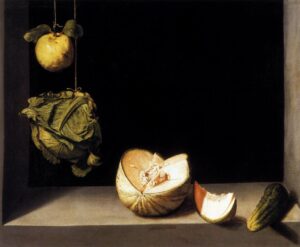Summary
Accomplished artists often include leading lines in their compositions, which utilize not only obvious lines but also rows of similar shapes, gradations, brush strokes, etc., to emphasize the main subject of their works, as well as to guide the viewer’s attention to the surrounding areas. Although these leading lines are hard to recognize for observers with no experience in art education, identifying these lines helps to understand the structure of artwork, and is said to be important in art education. Another problem is that the artist’s eyes become accustomed to their work over a long period, and the leading lines become hard to identify.
Saliency maps are used to locate attractive areas of still images and have been utilized in various fields, including advertising design, media quality assessment, and analysis of medical images. However, such scalar features do not express the trajectory of a viewer’s gaze.
In this project, we propose a visual analysis method for leading lines based on subgraphs of Morse–Smale complexes, known as the maximum graph, extracted from saliency maps. By abstracting the gradient field of saliency maps, we propose a method to identify leading lines for beginner artists and those who wish to learn how to appreciate art.

Subgraph of Morse–Smale complex (maximum graph)

Still-life With Quince, Cabbage, Melon, and Cucumber (Juan Sánchez Cotán, c. 1602)
Members
Members with gray background are not currently involved in the project. Members who still belong to Fujishiro Lab are marked with the Lab icon ![]() before their names.
before their names.
Publications
The underlined authors are current or past members of Fujishiro Lab.
Presentations
Refereed
- Fuminori Shibasaki and Issei Fujishiro: “Identification of leading lines in artworks based on topological analysis of saliency maps,” to appear in 2025 IEEE 18th Pacific Visualization Conference (PacificVis), 6 pages, Taipei, Taiwan, April 22–25, 2025.
- Fuminori Shibasaki and Issei Fujishiro: “Topological analysis and approximate identification of leading lines in artworks based on discrete Morse theory,” in 2023 IEEE Visualization and Visual Analytics (VIS), short paper, pp. 6–10, Melbourne, Australia, October 22–27, 2023, doi: 10.1109/VIS54172.2023.00010.
- Fuminori Shibasaki and Issei Fujishiro: “Topological analysis of leading lines in artworks based on discrete Morse theory,” in Proceeding of Visual Computing 2023, pp. 4:1–4:5, Shibaura Institute of Technology, September 17–20, 2023 (in Japanese).
Unrefereed
- Fuminori Shibasaki: “Visual analysis of leading lines in artworks based on discrete Morse theory and evaluation by design experts,” invited by The 7th Japan-Korea-China Joint Visualization Workshop, Keio University, Mita Campus, Tokyo, April 23, 2024.
- Fuminori Shibasaki and Issei Fujishiro: “A comparative study on visual analysis of leading lines based on differential topology and eye tracking results,” in Proceedings of Expressive Japan 2023 (The Technical Report of the Institute of Image Information and Television Engineers, Vol. 47, No. 9, pp.89–92, AIT2023–59), Tokyo Polytechnic University, online & onsite hybrid, March 6, 2023, Excellent Oral Presentation Award, Polyphony Digital Award (in Japanese).
- Fuminori Shibasaki and Issei Fujishiro: “Visual analysis of gaze direction strategies on static images based on differential topology,” in Proceedings of the 85th National Convention of International Processing Society of Japan, Vol. 2, pp. 939–940 (7X-01), The University of Electro-Communications, online & onsite hybrid, March 2–4, 2023, Student Encouragement Award (in Japanese).